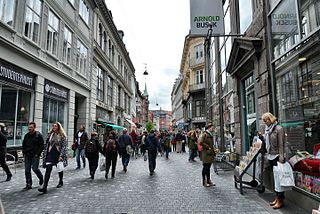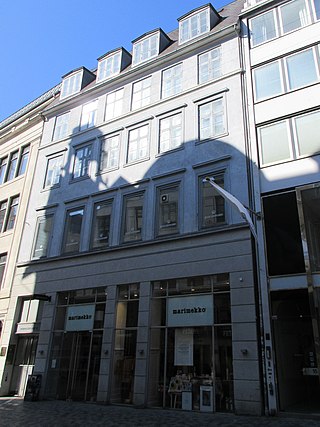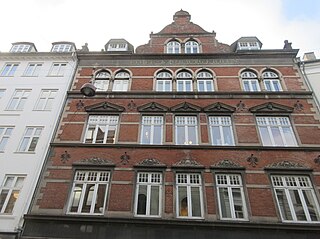
Kronprinsensgade 7 is a former Freemasons' hall located in Kronprinsensgade 7 in central Copenhagen, Denmark. The three-storey, Neoclassical building is from 1807. It was listed on the Danish registry of protected buildings and places in 1816.

Kronprinsensgade 7 is a former Freemasons' hall located in Kronprinsensgade 7 in central Copenhagen, Denmark. The three-storey, Neoclassical building is from 1807. It was listed on the Danish registry of protected buildings and places in 1816.

The site was formerly part of a much larger property which reached all the way from Købmagergade to Pilestræde. This property was listed in Copenhagen's first cadastre of 1689 as No. 11 in Købmager Quarter and belonged to count Reventlow at that time. [1]
The property was acquired by the master carpenter Johan Peter Boye Junge (1735–1807) in 1793 and he was subsequently granted royal permission to create the new street Kronprinsensgade on the site.

The building was constructed for De Forenede Frimurerloger by Peder Friis (1763–1831) in 1805–1807. It was inaugurated on 7 January 1807. The Freemasons left the building when they inaugurated their new headquarters at Klerkgade 2 on 6 October 1868. [2]
A.C. Perch's Tea Shop was founded in the building in 1835 but later moved to No. 5 where it is still located. The shop premises at No. 7 was later taken over by Jacob Lund's Bookshop. It had previously been based at Købmagergade 31 and specialized in scientific literature about medicine. It later moved to Pilestræde. [3]

The building in Kronprinsensgade was taken over by the Association of Craftsmen in Copenhagen in 1869. Their facilities included a reading room, a billiard room and a library with circa 2,000 volumes. The Association of Craftsmen relocated to the Moltke Mansion at the corner of Bredgade and Dronningens Rværgade in 1932. [4]
The building has more recently hosted Københavns Musikteater (Copenhagen Music Theatre) but it moved out in Spring 2016. [5]
The building consists of three storeys and a cellar and is five bays wide. Over the main entrance is a triangular pediment.
A Cheap Monday store is today located in the ground floor.

Købmagergade is a pedestrian shopping street in the Old Town of Copenhagen, Denmark. It connects Amagertorv on Strøget to Nørreport station, although the last section, north of Kultorvet, is part of Frederiksborggade, which continues on the other side of the railway station.

Varehuset Messen was a department store on Købmagergade in central Copenhagen, Denmark, operated by Hilligsøe, Køedt & Co.. The department store closed in 1971. The building was completed in 1895 to designs by Emil Blichfeldt. A branch of Niels Brock Copenhagen Business College is now based in the building. A plaque on the facade commemorates that Niels Steensen lived on the site.

Pilestræde is a street in central Copenhagen, Denmark. It is a side street to the pedestrianized shopping street Strøget and commonly associated with the newspaper publishing house Berlingske Media, which has its headquarters in the street.

Hauser Plads is a public square in the Old Town of Copenhagen, Denmark. It is separated from the larger, more well-known square Kultorvet by the former Copenhagen Central Library Building. A landscaped playground and Copenhagen Municipality's underground Cleaning Facilities Centre occupies most of the site since a renovation in 2011..

Kronprinsensgade is a street in the Old Town of Copenhagen, Denmark. It links the major shopping street Købmagergade in the west with Pilestræde in the east. The street is known for A.C. Perch's Rea Store.

Sværtegade 3 is a listed property in the Old Town of Copenhagen, Denmark, consisting of a four-storey building from the 18th century fronting the street and a large, three-winged building from 1829 in the courtyard. J. G Schwart & Søn was from 1806 to 1983 based at the site. The entire complex was listed on the Danish registry of protected buildings and places in 1918. Harald Conrad Stilling's shop facade and interior from 1847 is part of the heritage listing.

Thomas Andreas Blom was a Danish master mason, architect and developer who contributed to the rebuilding of Copenhagen in the years after the Copenhagen Fire of 1795 and the Battle of Copenhagen in 1807. He initially worked in a partnership with his mother and three brothers as Bloms Enke & Sønner, constructing approximately one building per year between 1799 and 1808. After being licensed as a master mason in 1810, he continued the work independently. Most of his surviving buildings are listed on the Danish registry of protected buildings and places. He was also active in Copenhagen Fire Corps, reaching the rank of deputy fire chief. He was a driving force behind the foundation of Håndværkerstiftelsen as a charity providing affordable accommodation for old craftsmen and their widows in difficult circumstances.

Købmagergade 13 is an 18th-century townhouse situated on the shopping street Købmagergade, between Amagertorv and Valkendorfsgade, in central Copenhagen, Denmark. It was listed in the Danish registry of protected buildings and places in 1974. The complex consists of a four-storey building towards the street, two consecutive, half-timbered side wings along one side of a courtyard, a cross wing, separating the first and second courtyard from each other,, another half-timbered side wing along one side of the second courtyard, and two rear wings. Notable former residents include the businessmen Peter Pierre Tutein, Friederich Tutein and Peter van Gemmert, book printer Andreas Seidelin, educator Jens Ernst Wegener and architect Gottlieb Bindesbøll.

Pilestræde 41–45 is a late 18th-century building complex in the Old Town of Copenhagen, Denmark, constructed by master mason Johan Peter Boye Junge in 1784–1786, Junge was also responsible for the construction of the adjacent buildings at Pilestræde 37–39 as well as a number of buildings around the corner in Kronprinsensgade. The three buildings were merged into a single property in 1935 and 1962. Two detached warehouses in the courtyards on the rear are also part of the property. The entire building complex was listed in the Danish registry of protected buildings and places in 1945. Johan Peter Boye Junge was himself a resident of Pilestræde 45 from 1798 to 1805. Other notable former residents include the Swedish military officer Curry Gabriel Treffenberg, clergyman and church historian Ludvig Helveg and ballet master at the Royal Danish Ballet August Bournonville.

Pilestræde 37/Kronprinsensgade 13 is an 18th-century building situated at the acute-angled corner of Pilestræde and Kronprinsensgade in the Old Town of Copenhagen, Denmark. It was listed in the Danish registry of protected buildings and places in 1945. It was constructed by the master mason and developer Johan Peter Boye Junge, who also constructed the buildings at Pilestræde 39–47 in conjunction with his creation of the street Kronprinsensgade, and who was himself a resident of the building from its completion in 1786. Other notable former residents include actors Michael and Johanne Rosing, printer Andreas Flinch, poet Christian Winther and Bing & Grøndahl co-founder Meyer Herman Bing.

Antonigade 9 is a late-18th-century residential building situated in the Old Town of Copenhagen, Denmark. It was constructed in 1766 to designs by architect Hans Næss, who was himself among the residents until his death almost thirty years later. The building was Danish registry of protected buildings and places in 1918. The scope of the heritage listing was expanded in 2000. Other notable former residents include Urban Bruun Aaskov, court bookdealer and publisher Simon Peter Poulsen, and theologian Otto Horrebow.

Pilestræde 39 is a late 18th-century building situated in Pilestræde in the Old Town of Copenhagen, Denmark. It was constructed by the master mason and developer Johan Peter Boye Junge, who also constructed the buildings at Pilestræde 37 and Pilestræde 41–45 in conjunction with his creation of the street Kronprinsensgade. It was listed in the Danish registry of protected buildings and places in 1945. The scope of the heritage listing was expanded in 1992. Jacob Trier's grocery business was for more than one hundred years—from the late 1840s until at least the 1950s—based in the building. Notable former residents include actors Joachim-Daniel Preisler (1755–1809) and Marie Cathrine Preisler (1761–1797) and painter Christian August Lorentzen (1749–1828).

Pilestræde 42 is an 18th-century building situated in Pilestræde in the Old Town of Copenhagen, Denmark. Originally a two-storey building from the 1730s, constructed on the foundations of Christian IV's Canon Foundry, it was later in the century heightened with two storeys. Pilestræde 42 and Pilestræde 44 were merged into a single property in the early 1970s. The two buildings were listed in the Danish registry of protected buildings and places in 1985.

Johan Peter Boye Junge was a Danish master carpenter, developer and head of the Copenhagen Fire Corps.

Sværtegade 1 / Pilestræde 40 is a heritage listed building situated at the corner of Pilestræde and Sværtegade in the Old Town of Copenhagen, Denmark. Originally a two-storey building from the 1730s, constructed on the foundations of Christian IV's Canon Foundry, it was later heightened twice, first with one storey in 1812 and then with another one in 1850. Christian Steen opened a bookshop in the building in the 1810s. Other notable former residents include the architect Wilhelm Klein. In the middle of the 20th century, Pilestræde 40 became known as Glargården after having been acquired by Copenhagen's Glaziers Guild. The building was listed in the Danish registry of protected buildings and places in 1986. It is now owned by Odense-based Barfoed Group.

Købmagergade 36/Kronprinsensgade 1 is a Neoclassical building situated at the corner of the shopping street Købmagergade and Kronprinsensgade in central Copenhagen, Denmark. Constructed for dorector of the Royal Greenland Trade Department Hartvig Marcus Frisch in 1795, some ten years after Kronprinsessegade was established at private initiative by Johan Peter Boye Junge, a master builder and head of Copenhagen Fire Corps, it was shortly thereafter sold to the wealthy widow Cecilie Rosted, who kept it until her death. From 1826 to 2003, it was then home to the Royal Military and Vajsenhus Pharmacy. The pharmacy is now located at nearby Landemærket 1–3. Other notable former residents of the building include the painter Vilhelm Groth.

Købmagergade 44 is the former headquarters of Holger Petersen's textile company in Copenhagen, Denmark. The present building on the site, which is from the 1880s, replaced the Royal Waisen House, a combined school and orphanagefor indigent children, which relocated to a new purpose-built school building on Nørre Farimagsgade. The institution's old building on Købmagergade was a former Baroque style town mansion from the 1740s, whose earlier residents included Russian envoy to Copenhagen Johann Albrecht Korff and businessmen Joost and Peter van Hemert. From 1971 to 2017, University of Copenhagen's Department of Theology was based in the building. It is now part of the Trinity Quarter, a mixed-use complex owned by Hines, with a 24-hour boutique hotel, retail and six residential apartments.

Købmagergade 38 is a building on Købmagergade in Copenhagen, Denmark. C. G. Iversen's Bookshop was located in the building from 1846 to 1857. It was later continued as Tillge's Bookshop, first by E. S.Tillge and then by his son Holger Tillge. E. S. Tillge's brother, Vilhelm Tillge, operated a photographic studio in the building from 1873 to 1893.

Lille Købmagerhus is a Renaissance Revival style building situated on Købmagergade in Copenhagen, Denmark. It was constructed in c. 1800 for coffee retailer Christian P Hansen to designs by architect A. B. C. von Düben. The inclusion of "Lille" in its name destinguishes it from the slightly older and somewhat larger Købmagerhus further down the street. Peder Hvitfeldts Stræde 4, a three-storey building from 1812 on the other side of the block, is also part of the property. Notable former residents of Peder Hvidtfeldts Stræde 4 include the philosopher Frederik Christian Sibbern, botanist and politicianJoakim Frederik Schouw and architectPeter Kornerup. The property is today owned by Kirkebi A/S.

Købmagerhus is a commercial building situated at the corner of the shopping street Købmagergade and Silkegade in central Copenhagen, Denmark, built in 1898 to a Jugend style design by Chr. Hansen. A plaque on the facade commemorates that Niels Steensen was born on the site. Café de Grandeville, a café with live music, was originally located on the ground floor of the building. Its former premises were later converted into a cinema, Højbro Teatret, with just 251 seats, An earlier building on the site was built in 1731 for court jeweller Frederich Fabricius. It was later passed to his son and grandson, Christopher and Frederik Fabricius, both of whom also served as court jewellers. Copenhagen's first gentlemen's club, referred to variously as Fabricius' Club and "the club on Købmagergade", was based in the building.